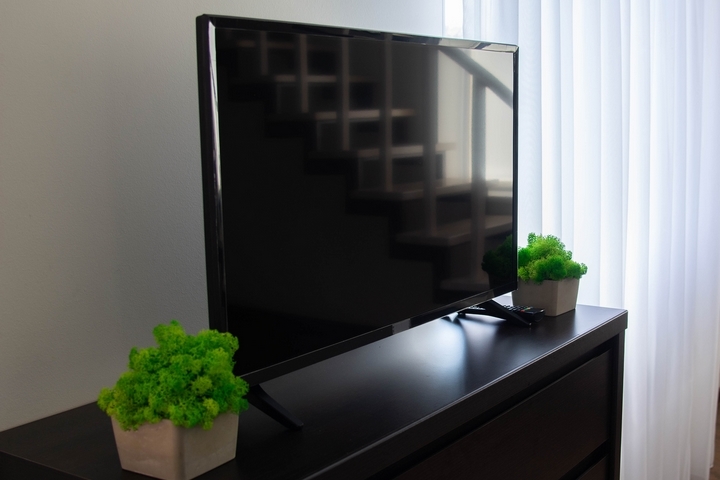A midday movie or a Saturday morning show can be annoyingly disrupted by the glare of the light coming through your windows. A badly placed light, or a shiny decoration can cause flare and glare too at all times of day. The last thing you want to be dealing with when you’re trying to rest and relax is an annoying glare that.
Luckily, there are plenty of tips on how to stop window glare on TV, so take your pick! Which of the tips below is the solution for you?
1. Install some good blinds
 Installing blinds is an easy way to stop window glare on the TV. The biggest cause of glare on a TV screen is from natural light coming in through a window. Using blinds will eliminate that. Curtains can also do the trick, but since they are usually loose panels of fabric that aren’t flush against the window, at certain times of day and from certain angles, the natural light may still be able to peak through.
Installing blinds is an easy way to stop window glare on the TV. The biggest cause of glare on a TV screen is from natural light coming in through a window. Using blinds will eliminate that. Curtains can also do the trick, but since they are usually loose panels of fabric that aren’t flush against the window, at certain times of day and from certain angles, the natural light may still be able to peak through.
To avoid having to resort to creative methods of holding your curtains in place, it is best to have blinds instead. If you like the look of curtains, you can actually double up by installing both.
2. Find the best spot for the TV
 Depending on which direction your home faces, and where your windows are situated, there may be a sweet spot in your home where the TV will not be disrupted by light. Analyze the light movement in the TV room to see if such a place exists, and pinpoint the spot where the light reaches the least. Corners are often great places to stick the TV, as the light often can’t reach them. Also, keep in mind that the sun rises in the east and sets in the west, and place your TV accordingly
Depending on which direction your home faces, and where your windows are situated, there may be a sweet spot in your home where the TV will not be disrupted by light. Analyze the light movement in the TV room to see if such a place exists, and pinpoint the spot where the light reaches the least. Corners are often great places to stick the TV, as the light often can’t reach them. Also, keep in mind that the sun rises in the east and sets in the west, and place your TV accordingly
3. Install an anti-glare screen protector
 The screen of your TV may have a glossy finish, which will contribute to the glare caused by both natural and non-natural lighting. These protectors essentially give the screen a matte finish, which doesn’t have the ability to reflect as much light, but which will still allow the picture from the screen to come through crystal clear.
The screen of your TV may have a glossy finish, which will contribute to the glare caused by both natural and non-natural lighting. These protectors essentially give the screen a matte finish, which doesn’t have the ability to reflect as much light, but which will still allow the picture from the screen to come through crystal clear.
4. Adjust the lighting
 Why does the movie theatre turn down the lights when you go to watch a movie? Easy. Because it allows the viewers to see the screen better. It’s the same thing in your own home. Turning off the lights will allow you to better see the screen. Understandably, you may not want to live in total darkness all the time.
Why does the movie theatre turn down the lights when you go to watch a movie? Easy. Because it allows the viewers to see the screen better. It’s the same thing in your own home. Turning off the lights will allow you to better see the screen. Understandably, you may not want to live in total darkness all the time.
An easy fix is to see about installing light dimmers, or adding a couple of lamps into the room, instead of using the big ceiling lights. You may also want to buy a white gloss TV stand with LED lights, which provide you with a cool lighting source.
5. Move the lighting
 The problem with watching TV in total darkness is that it can contribute to eye fatigue. Everything around you is dark, and the only stimuli your eyes are picking up is a bright moving screen. Instead of turning off all the lighting, move the light source behind the TV. This way it can’t interfere with the screen, it will decrease eye fatigue and it will allow you to still have a bit of light in the room.
The problem with watching TV in total darkness is that it can contribute to eye fatigue. Everything around you is dark, and the only stimuli your eyes are picking up is a bright moving screen. Instead of turning off all the lighting, move the light source behind the TV. This way it can’t interfere with the screen, it will decrease eye fatigue and it will allow you to still have a bit of light in the room.
6. Adjust the TV
 Most people take their TV as it is set. Most of the time this is perfectly fine, but turning up the brightness can help reduce window glare. The reason this is the best setting to adjust here is because you are working to make the screen brighter than the light that is causing the glare. It will also throw off your viewing experience when you go to watch it once the sun has set, or once you close the blinds. As well, turning up the brightness can throw off some of the other settings, ultimately decreasing the quality of the picture. But it definitely works in a pinch.
Most people take their TV as it is set. Most of the time this is perfectly fine, but turning up the brightness can help reduce window glare. The reason this is the best setting to adjust here is because you are working to make the screen brighter than the light that is causing the glare. It will also throw off your viewing experience when you go to watch it once the sun has set, or once you close the blinds. As well, turning up the brightness can throw off some of the other settings, ultimately decreasing the quality of the picture. But it definitely works in a pinch.
7. Tuck it away
 You could also invest in a TV cabinet to reduce window glare. If you place the TV a little bit back on the shelf, the screen will be protected on each side from the sun. It may, however, decrease visibility if you have seating that does not look straight at the TV.
You could also invest in a TV cabinet to reduce window glare. If you place the TV a little bit back on the shelf, the screen will be protected on each side from the sun. It may, however, decrease visibility if you have seating that does not look straight at the TV.
8. Block the light
 The bottom line is that you need to interrupt the light from reaching the screen in order to eliminate the glare. This can be done in many different ways, and depends almost exclusively on where your windows are, what angles they hit your TV screen at, and what resources you have at your disposal.
The bottom line is that you need to interrupt the light from reaching the screen in order to eliminate the glare. This can be done in many different ways, and depends almost exclusively on where your windows are, what angles they hit your TV screen at, and what resources you have at your disposal.
You could use a privacy screen as a decorative method for blocking the light, or a creatively placed tree or hanging plant. There is no end to the decorations and furniture you can use to creatively protect your TV screen from light. The best part is, you’ll be simultaneously creating a unique living environment.




